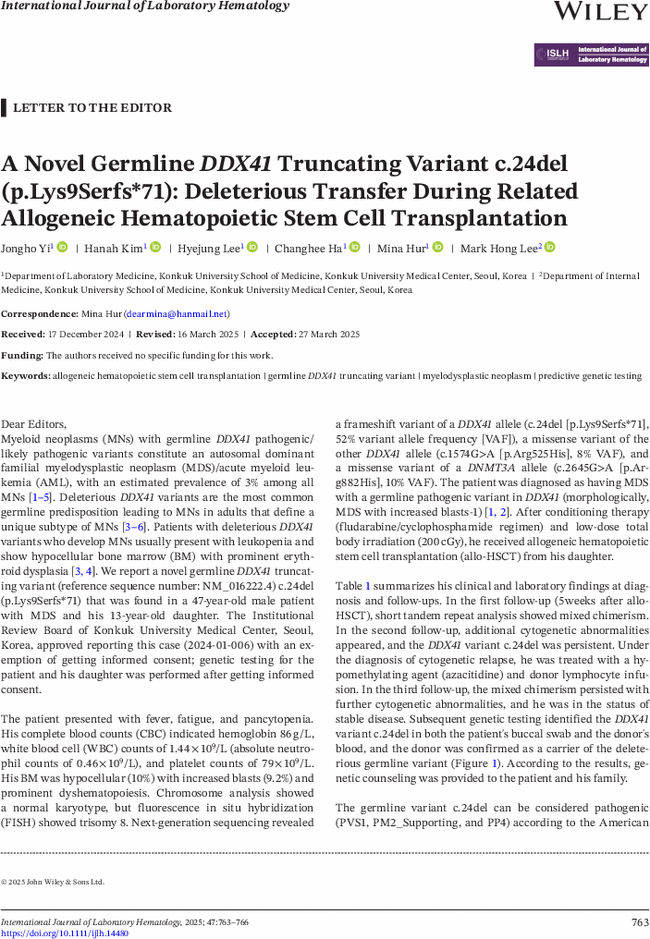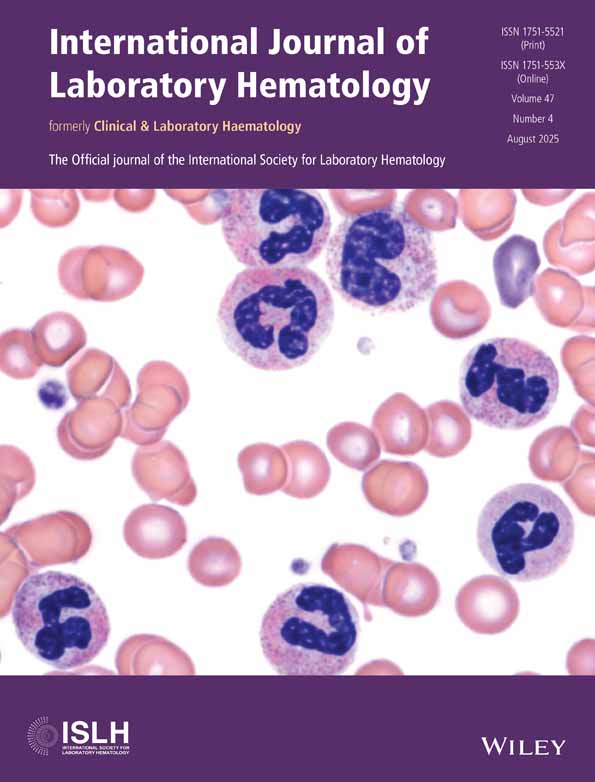A Novel Germline DDX41 Truncating Variant c.24del (p.Lys9Serfs*71): Deleterious Transfer During Related Allogeneic Hematopoietic Stem Cell Transplantation
Jongho Yi
Department of Laboratory Medicine, Konkuk University School of Medicine, Konkuk University Medical Center, Seoul, Korea
Search for more papers by this authorHanah Kim
Department of Laboratory Medicine, Konkuk University School of Medicine, Konkuk University Medical Center, Seoul, Korea
Search for more papers by this authorHyejung Lee
Department of Laboratory Medicine, Konkuk University School of Medicine, Konkuk University Medical Center, Seoul, Korea
Search for more papers by this authorChanghee Ha
Department of Laboratory Medicine, Konkuk University School of Medicine, Konkuk University Medical Center, Seoul, Korea
Search for more papers by this authorCorresponding Author
Mina Hur
Department of Laboratory Medicine, Konkuk University School of Medicine, Konkuk University Medical Center, Seoul, Korea
Correspondence:
Mina Hur ([email protected])
Search for more papers by this authorMark Hong Lee
Department of Internal Medicine, Konkuk University School of Medicine, Konkuk University Medical Center, Seoul, Korea
Search for more papers by this authorJongho Yi
Department of Laboratory Medicine, Konkuk University School of Medicine, Konkuk University Medical Center, Seoul, Korea
Search for more papers by this authorHanah Kim
Department of Laboratory Medicine, Konkuk University School of Medicine, Konkuk University Medical Center, Seoul, Korea
Search for more papers by this authorHyejung Lee
Department of Laboratory Medicine, Konkuk University School of Medicine, Konkuk University Medical Center, Seoul, Korea
Search for more papers by this authorChanghee Ha
Department of Laboratory Medicine, Konkuk University School of Medicine, Konkuk University Medical Center, Seoul, Korea
Search for more papers by this authorCorresponding Author
Mina Hur
Department of Laboratory Medicine, Konkuk University School of Medicine, Konkuk University Medical Center, Seoul, Korea
Correspondence:
Mina Hur ([email protected])
Search for more papers by this authorMark Hong Lee
Department of Internal Medicine, Konkuk University School of Medicine, Konkuk University Medical Center, Seoul, Korea
Search for more papers by this authorFunding: The authors received no specific funding for this work.

Open Research
Data Availability Statement
The data that support the findings of this study are available from the corresponding author upon reasonable request.
References
- 1J. D. Khoury, E. Solary, O. Abla, et al., “The 5th Edition of the World Health Organization Classification of Haematolymphoid Tumours: Myeloid and Histiocytic/Dendritic Neoplasms,” Leukemia 36 (2022): 1703–1719.
- 2D. A. Arber, A. Orazi, R. P. Hasserjian, et al., “International Consensus Classification of Myeloid Neoplasms and Acute Leukemias: Integrating Morphologic, Clinical, and Genomic Data,” Blood 140 (2022): 1200–1228.
- 3H. Makishima, R. Saiki, Y. Nannya, et al., “Germ Line DDX41 Mutations Define a Unique Subtype of Myeloid Neoplasms,” Blood 141 (2023): 534–549.
- 4H. Makishima, T. V. Bowman, and L. A. Godley, “DDX41-Associated Susceptibility to Myeloid Neoplasms,” Blood 141 (2023): 1544–1552.
- 5Y. Kusne, T. Badar, T. Lasho, et al., “Prevalence of Cytopenia(s) and Somatic Variants in Patients With DDX41 Mutant Germline Predisposition Syndrome,” British Journal of Haematology, ahead of print, March 4, 2025, https://doi.org/10.1111/bjh.20018.
- 6E. J. Choi, Y. U. Cho, E. H. Hur, et al., “Unique Ethnic Features of DDX41 Mutations in Patients With Idiopathic Cytopenia of Undetermined Significance, Myelodysplastic Syndrome, or Acute Myeloid Leukemia,” Haematologica 107 (2022): 510–518.
- 7S. Richards, N. Aziz, S. Bale, et al., “Standards and Guidelines for the Interpretation of Sequence Variants: A Joint Consensus Recommendation of the American College of Medical Genetics and Genomics and the Association for Molecular Pathology,” Genetics in Medicine 17 (2015): 405–424.
- 8 ClinGen, “ClinGen Sequence Variant Interpretation Recommendation for PM2—Version 1.0 Working Group Page,” 2020, https://clinicalgenome.org/working-groups/sequence-variant-interpretation/.
- 9A. Maierhofer, N. Mehta, R. A. Chisholm, et al., “The Clinical and Genomic Landscape of Patients With DDX41 Variants Identified During Diagnostic Sequencing,” Blood Advances 7 (2023): 7346–7357.
- 10J. Versluis, W. Saber, H. K. Tsai, et al., “Allogeneic Hematopoietic Cell Transplantation Improves Outcome in Myelodysplastic Syndrome Across High-Risk Genetic Subgroups: Genetic Analysis of the Blood and Marrow Transplant Clinical Trials Network 1102 Study,” Journal of Clinical Oncology 41 (2023): 4497–4510.
- 11C. J. Gibson, H. T. Kim, L. Zhao, et al., “Donor Clonal Hematopoiesis and Recipient Outcomes After Transplantation,” Journal of Clinical Oncology 40 (2022): 189–201.
- 12P. Hirsch, D. Bories, E. Chapiro, et al., “Successive Relapses From Donor and Host Cells in a Patient With DEAD-Box Helicase 41 (DDX41)-Associated Myelodysplastic Syndrome: The Lessons to Be Learned,” British Journal of Haematology 199 (2022): 623–626.
- 13B. Rolles, R. Meyer, M. Begemann, et al., “DDX41 Germline Variants Causing Donor Cell Leukemia Indicate a Need for Further Genetic Workup in the Context of Hematopoietic Stem Cell Transplantation,” Blood Cancer Journal 13, no. 1 (2023): 73, https://doi.org/10.1038/s41408-023-00846-2.
- 14A. Clark, S. Thomas, A. Hamblin, et al., “Management of Patients With Germline Predisposition to Haematological Malignancies Considered for Allogeneic Blood and Marrow Transplantation: Best Practice Consensus Guidelines From the UK Cancer Genetics Group (UKCGG), CanGene-CanVar, NHS England Genomic Laboratory Hub (GLH) Haematological Malignancies Working Group and the British Society of Blood and Marrow Transplantation and Cellular Therapy (BSBMTCT),” British Journal of Haematology 201 (2023): 35–44.
- 15P. Baliakas, B. Tesi, J. Cammenga, et al., “How to Manage Patients With Germline DDX41 Variants: Recommendations From the Nordic Working Group on Germline Predisposition for Myeloid Neoplasms,” Hema 8 (2024): e145.




